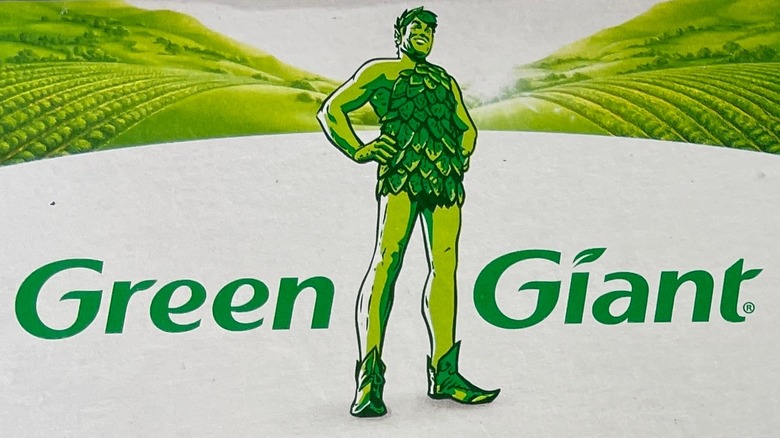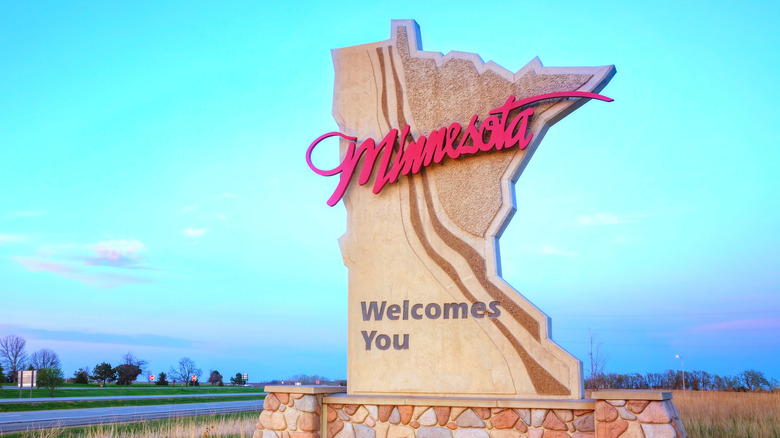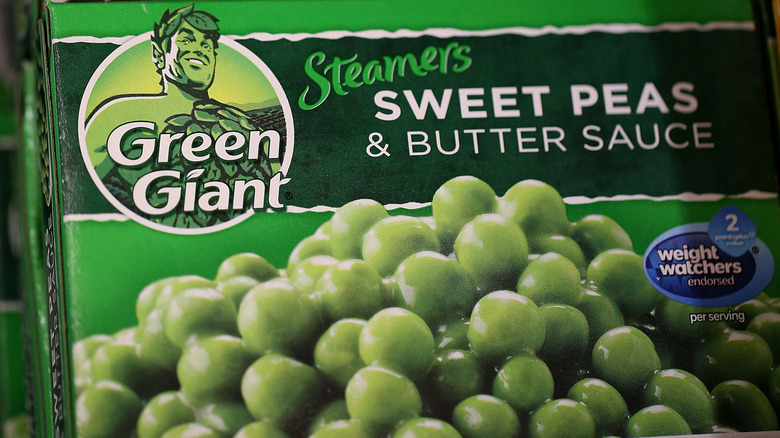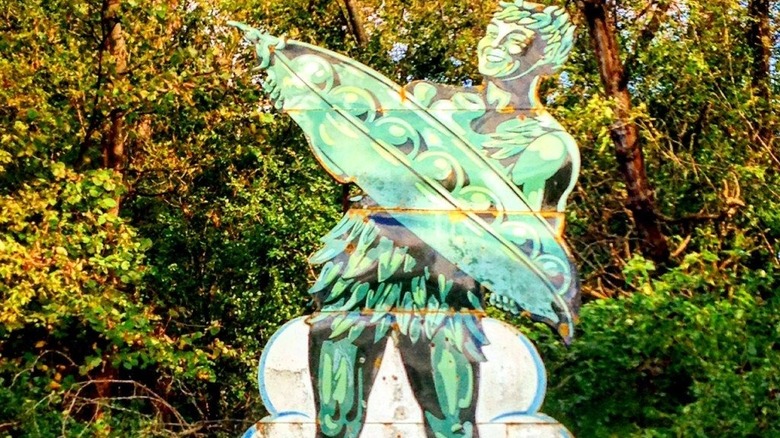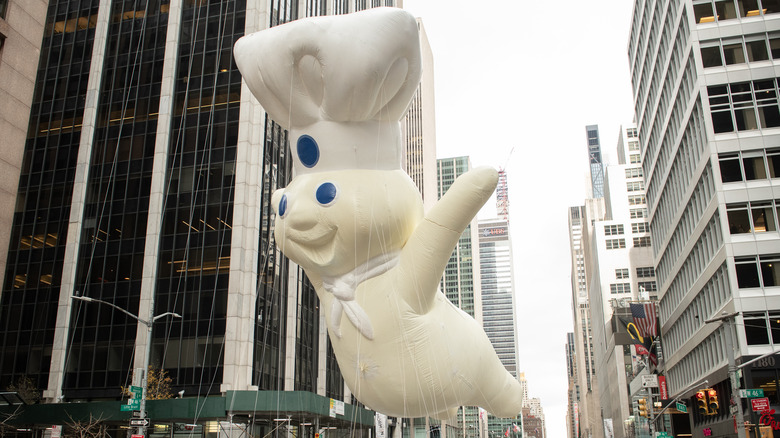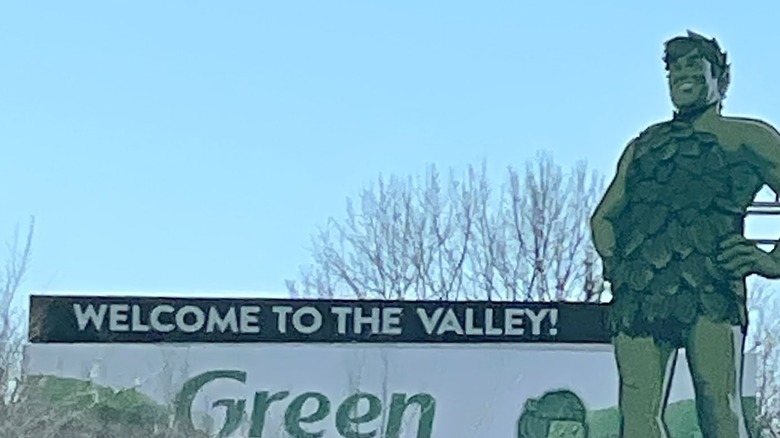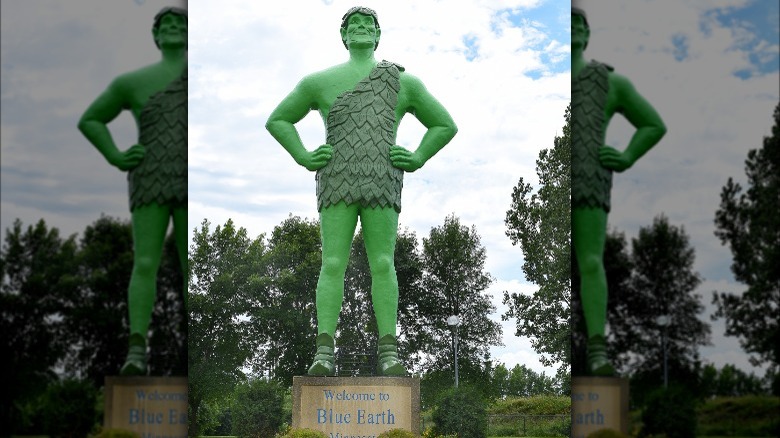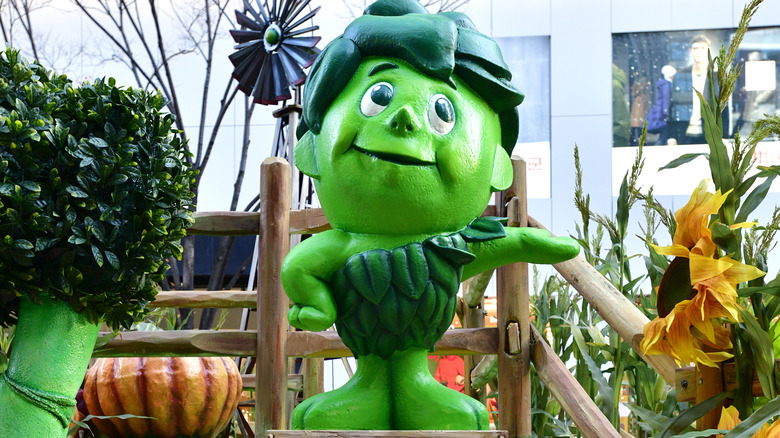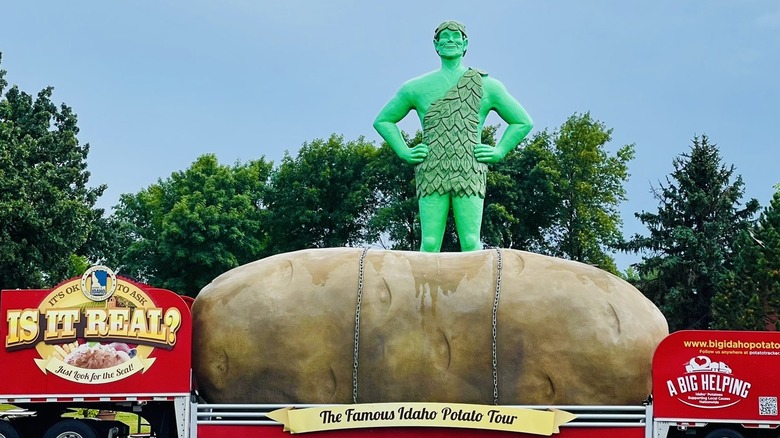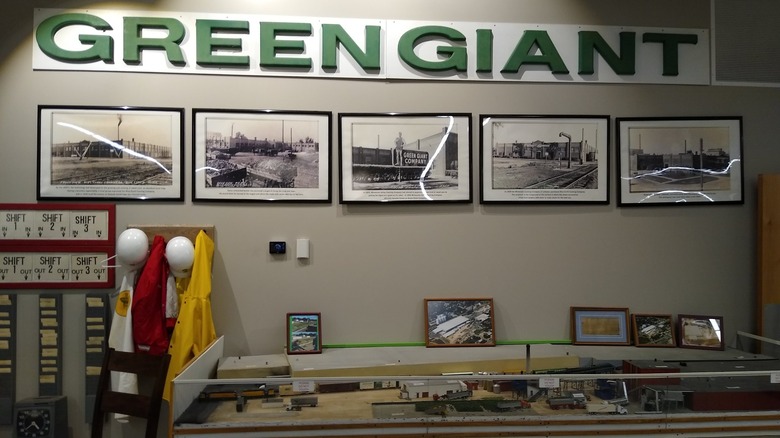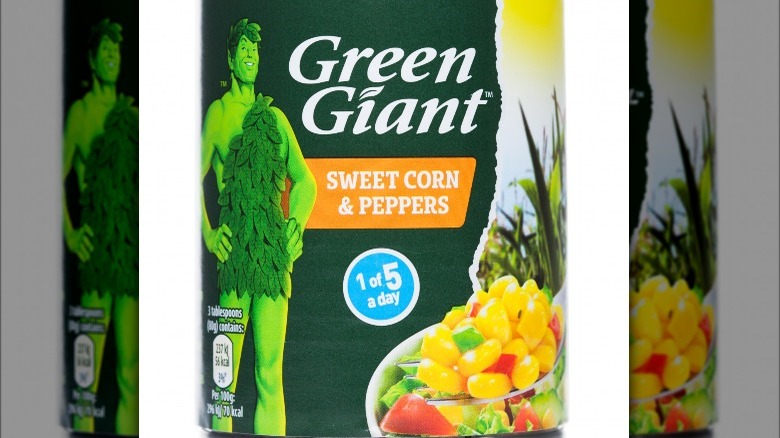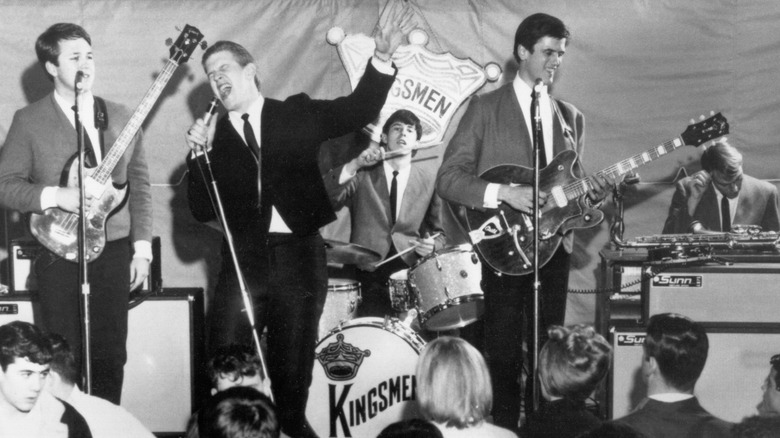13 Facts To Know Before Buying Green Giant Vegetables Again
If you hear a deep voice bellowing "ho, ho, ho" within earshot, what do you picture? Is it a red-faced, toy-delivering obese man ... or an enormous, green-skinned giant? While we'd venture to guess Santa Claus is most associated with the three-word phrase — because, realistically, no one could usurp Kris Kringle's claim to his iconic laugh — the sheer fact it's a question at all illustrates the stature of the Jolly Green Giant. Of course, the Jolly Green Giant wouldn't have become a beloved icon of Americana without the actual company he represents: Green Giant.
First founded in 1903, Green Giant vegetable products are familiar to most people in this day and age. After all, it's impossible to ignore a company with more than a century of bonafide success, or a track record as one of the leading producers of canned corn and peas in the U.S. (via MNopedia). Frankly, Green Giant doesn't just own the most iconic food mascot of all time — it may be the most iconic food company in U.S. history, as well.
Consequently, many of us possess some knowledge about Green Giant vegetables and the company's various products. But that doesn't mean the average person knows everything there is to know about them. In that spirit, we've assembled 13 interesting tidbits about the produce company. So read on, and discover what you need to know before buying Green Giant vegetables again.
It was first founded as the Minnesota Valley Canning Company in 1903
What's in a name, really? Well, when it comes to corporate America, it largely depends on what a company's trying to convey. Some business owners may prefer a bare-bones approach and opt for a severely straightforward name, one that leaves no doubt about what a company does. Now, we're obviously not privy to the thought processes of Green Giant's founders. But considering the company was originally named Minnesota Valley Canning Company when first starting in 1903 (via Green Giant), we're presuming clear-cut simplicity was a goal.
The Minnesota Valley Canning Company began in Le Sueur, Minnesota, at the dawn of widespread industrial canning in the U.S. (via MNopedia). Initially selling canned creamed corn, according to the Minnesota Valley History Learning Center, the company soon incorporated canned peas into its product line in 1907. Naturally, the produce for these canned products was grown locally in the Minnesota Valley, hence the company's original, plainly descriptive moniker.
We'd have to believe the Minnesota Valley Canning Company name accomplished what it intended. In fact, the company actually remained under this original name until 1950, when it officially changed to match up with its popular Jolly Green Giant mascot.
The Green Giant name was devised to describe a new pea in 1925
We can't imagine too many folks have ever really wondered where the "Green Giant" name originated. After all, it lines up perfectly with the company's internationally famous mascot, the Jolly Green Giant, so what else is there to know? But whether or not you've ever pondered the name, the origin story of the Green Giant moniker is actually quite intriguing. Because when company board member Ward Cosgrove first conceived the name, it wasn't for a mascot — it was for a new, larger pea he'd brought to the U.S. from England in 1925 (via Minnesota Valley History Learning Center).
Now, for some reason, according to MNopedia, consumers in the 1920s believed smaller peas were better than larger varieties. But Cosgrove thought he'd discovered a larger pea across the Atlantic that was just as delicious and tender as smaller ones. Hoping for a name that would easily communicate its girth to customers, Cosgrove came up with Green Giant and submitted an application to patent the new pea under that name.
The proposed name was deemed too vague for a new vegetable and was rejected by the patent office. But the company was eager to retain the trademark to the Green Giant name, so it created a mascot — eventually leading to the Jolly Green Giant.
The original Jolly Green Giant mascot had little in common with the modern version
The evolution of pop-culture characters over time is often notable, whether it happens organically or not. Nothing in the world is static, after all, so changes to well-known, long-running characters in the public eye are often unavoidable. Considering the Jolly Green Giant has remained virtually unchanged since 1936 (via Walker Art Center), some may presume the mascot has always been depicted as a green-skinned, leaf-wrapped man. But the mascot we all know and love today actually bears very little resemblance to the original incarnation from the 1920s.
For one thing, the first Jolly Green Giant wasn't green, nor was he very jolly, according to Minnesota Valley History Learning Center. In fact, the original mascot was actually a white man wearing a brown, furry, toga-like outfit. He was depicted as a scowling, unpleasant purveyor of giant peas.
While it's hard to imagine the thought process behind the first Green Giant mascot, we do have to credit the company for quickly realizing the need to pivot away from that original version. By 1930, the character's skin was green, and the brown fur-type outfit was replaced with green leaves (via Green Giant). And, within the decade, the Jolly Green Giant had morphed into his now-long-standing appearance.
The Jolly Green Giant was created by the same agency behind other famous food mascots
The creative contributions of advertising executives are often overlooked. Even the peerlessly charismatic Don Draper (Jon Hamm) would have a hard time standing out in the real world, since the (fictional) "Mad Men" character is quite possibly the only household name in U.S. advertising. With that in mind, we wouldn't be stunned if few people had ever heard of advertising legend Leo Burnett. But Burnett didn't just create the Jolly Green Giant character — he was responsible for several other beloved pop-culture icons, too, including the Pillsbury Doughboy and Tony the Tiger (via HuffPost).
To say Burnett created the Jolly Green Giant from scratch isn't entirely accurate. But he was largely responsible for the famous food mascot morphing from its original glum (and white-skinned) Green Giant, into the joyous, green-skinned version modern that consumers are familiar with. In fact, according to MNopedia, it was Burnett himself who suggested rebranding the company's mascot as the Jolly Green Giant in 1935.
While the quality of Green Giant's products has never been in question, the introduction of Burnett's happier, friendlier mascot undoubtedly helped propel the company forward through the years (via The One Club). And, eventually, the mascot's popularity led the company to rebrand itself as the Green Giant Company in 1950.
The company sells much more than just canned vegetables
Many consumers know Green Giant's signature products consist of canned vegetables (presumably) grown in the valley of the Jolly – ho, ho, ho – Green Giant, of course. But if you were under the impression the produce company's purview is exclusively canned vegetables, you'd be sorely mistaken. Not only does the company sell a number of frozen vegetables, but it also produces veggie-substitute products and a number of riced-vegetable items, as well (via Green Giant).
Green Giant's decision to diversify its products over time is expected, given that it's been in business for over a century. It offers Riced Veggies products (consisting of riced-sized bits of frozen vegetables mixed with other vegetables) as well as a line of various vegetable Swap-Ins.
The Swap-ins line offers healthy, vegetable-based substitutes for many typically unhealthy food items. As of 2022, these products include zucchini tots (minus the "tater"), mashed cauliflower (rather than potatoes), and veggie spirals (in lieu of pasta), just to name a few. Frankly, we can't say whether Green Giant's veggie substitutes will satiate consumer cravings like the real deal. But if the products help some folks incorporate more vegetables into their diets, we'd find that reason to cheer.
There's an area unofficially known as the 'Valley of the Jolly Green Giant'
The affection many south central Minnesota residents have toward Green Giant vegetables is easy to understand. Frankly, since the company was originally founded, named after, and based in the geographic area in which it resided — as the Minnesota Valley Canning Company (via Minnesota Valley History Learning Center) — it makes perfect sense. But the Minnesota Valley isn't the name most modern consumers would associate with that area. Rather, the majority are apt to know it as the Valley of the Jolly Green Giant (via CBS News).
Now, to be clear, there doesn't seem to be any official designation declaring the valley is, or actually should be, named after the Jolly Green Giant. But given how successful the company's well-known 1960s jingle was — touting its products did, indeed, come from the mascot's so-called personal valley — it's easy to see how the informal name stuck.
In addition, a sign along Highway 169 (on the edge of Le Sueur, Minnesota) does, in fact, welcome travelers to Green Giant's "valley" (via KARE-11). In other words, the valley of the Jolly Green Giant may not be officially sanctioned, but it'll always be a name that resonates with consumers.
An enormous Jolly Green Giant statue stands in Blue Earth, Minnesota
Did you know Green Giant has something in common with the Statue of Liberty? After all, the company's joyful mascot sometimes appears nearly as tall as the famed symbol of freedom gifted by France in 1871. But while the cartoon version of the Jolly Green Giant may measure up to the 305-foot-tall Statue of Liberty (via National Park Service), the 55-foot tall Jolly Green Giant statue in the city of Blue Earth, Minnesota, actually pales in comparison to the New York-based sculpture (via RoadsideAmerica.com).
Built in 1979, the Jolly Green Giant was the brainchild of radio station owner Paul Hedberg (via CBS News) during the construction of Interstate 90 in Minnesota. Hedberg worried the highway set to run alongside Blue Earth would substantially reduce the number of travelers who'd stop in town. Eager to help (and save his station), Hedberg coordinated with the Green Giant company, according to MinnPost.com, and raised funds to construct a giant (no pun intended) Jolly Green Giant statue along the highway.
Confident a statue could entice folks to stop off in Blue Earth, Hedberg was able to raise more than $50,000 for the project in a single week. One year later, the statue was erected. While a spot right alongside Interstate 90 wasn't feasible, the Jolly Green Giant eventually found a home about a mile away. More than four decades later, there he remains: beckoning all to bask in his glory.
A sidekick to the Jolly Green Giant, Little Sprout, was introduced in 1973
The introduction of a new companion to a successful character or ensemble is often met with suspicion. Perhaps it's the cloying cuteness that tends to accompany these new characters, or the clearly cynical, borderline-desperate vibes they give off — a la Chrissy Seaver (Ashley Johnson) on "Growing Pains," or "The Brady Bunch" with Cousin Oliver (Robbie Rist). Of course, just as pop-culture characters outside of television shows aren't immune to this trend, not all newly introduced characters are doomed for hatred. After all, does anyone truly hate Little Sprout, the Jolly Green Giant's lesser-known sidekick, who first appeared around 1973 (via MNopedia)?
Little Sprout was introduced as an apprentice, so to speak, to the Jolly Green Giant. Clearly intended as a way to appeal to children (and, therefore, drive them to gleefully consume their vegetables), Little Sprout was essentially a child, too, according to Pop Icon. Often seen in commercials learning valuable lessons from the Jolly Green Giant, Sprout was a prominent secondary mascot for the company until the 1990s.
Though Little Sprout may not be as popular as the Jolly Green Giant, we wouldn't lump the little guy in with other famously despised creations, either. For one thing, Sprout wasn't buried or forgotten over time. He even had his own Instagram account as of 2016, where he photographed a cross-country "road trip" alongside the Jolly Green Giant himself.
Multiple Giant Days celebrations are held annually in Minnesota
No one disputes La Sueur, Minnesota, was the original home of Green Giant vegetables (via MNopedia). But that doesn't mean it's the only town that sees itself as the hub for all things connected to Green Giant in the Land of Ten Thousand Lakes. In fact, roughly 67 miles south of La Sueur, the town of Blue Earth, Minnesota, gives the birthplace of Green Giant a run for its money. After all, Blue Earth isn't just home to the famous Jolly Green Giant statue and a Green Giant museum (via RoadsideAmerica.com) — it also hosts an annual Giant Days Celebration in July, as well.
A multi-day festival featuring numerous events, food vendors, live music, a parade, and fireworks, the Blue Earth Giant Days Celebration commemorates the town's agricultural history (via Blue Earth Chamber) — including, of course, its Green Giant heritage. It's unclear exactly when the celebration first began, but considering the Blue Earth Chamber website currently features a countdown to the start of the July 2023 festival, it's safe to say it won't be ending any time soon.
But, in a twist that seems too good to be true, La Sueur actually hosts its own Giant Days festival during the first weekend of August, as well (via La Sueur County News). The two festivals appear unrelated, as the Facebook page for the La Sueur celebration makes no mention of the Blue Earth event. In other words? An intrastate Green Giant rivalry may, in fact, exist.
The Green Giant museum lets visitors explore company history
Sometimes, we're not entirely sure why a museum exists. Sure, we understand the inherent rationale for museums, and wholeheartedly agree that having places to explore and learn about various historical or educational topics is of paramount importance. But while a company in business for nearly 120 years as of 2022 undoubtedly has a long, colorful history, it's still sort of baffling to consider an actual Green Giant museum exists in Blue Earth, Minnesota (via RoadsideAmerica.com).
According to Blue Earth Chamber, the Green Giant museum contains information about the company and its history as well as exhibits about the vegetable canning process. The biggest attraction, though, is likely the merchandise on display. Thanks to longtime former Green Giant employee Lowell Steen, the museum can credibly claim it's home to the largest collection of Green Giant memorabilia in the world (via CBS News).
On second thought, we can actually see why Blue Earth decided to open a museum dedicated to Green Giant. After all, the company does have a legitimately interesting story, particularly when the cultural impact of the Jolly Green Giant is taken into account. In addition, as a way to drum up potential interest in the town and area, we can respect Blue Earth's decision to share Green Giant's history with interested travelers.
The famous 'ho, ho, ho' catchphrase was voiced by the same actor for 40 years
It's virtually impossible to argue the Jolly Green Giant has a stronger cultural claim to the "ho, ho, ho" catchphrase than Jolly Old Saint Nick. But that likely didn't bother Len Dresslar, the man who voiced the Giant's famed three-word declaration in advertisements from 1959 until 1999 (via The New York Times). After all, not only did he credit his Jolly Green Giant work with financing the college educations for his two daughters, but he was also quick to note the job required very little actual work (via Los Angeles Times).
Speaking with the Detroit Free Press in 1999 (via Los Angeles Times), Dresslar stated his work as the Jolly Green Giant made him the "king of the minimalists." His deep-bellowed "ho, ho, ho" may be burned into the brains of many modern consumers, but Dresslar literally spoke those three words ... and did nothing else.
Regardless of how little was supposedly required of the talented artist, Dresslar's legacy in the American pop-cultural lexicon is set in stone. Aside from the Jolly Green Giant, the late actor was known for voicing the Marlboro Man, Dig-'em the Sugar Smacks frog, and Snap (of Snap, Crackle, and Pop) for Rice Krispies.
The Kingsmen had a minor hit with the song 'The Jolly Green Giant'
After nearly a century in the public spotlight, the Jolly Green Giant has undeniably stretched his influence beyond the vegetable company's advertisements. Frankly, the appeal of the gigantic creature (who rocks foliage clothes) knows no bounds in the cultural zeitgeist. Yet no appearance or reference to Green Giant's titular mascot may be more impressive or memorable than the release of the 1964 single, "The Jolly Green Giant," from the rock band, The Kingsmen.
Best known for their raucous cover of the classic tune, "Louie Louie," The Kingsmen were a fairly big deal during the first half of the 1960s. It's easy to see why when listening to their version of "The Jolly Green Giant," which is somewhat based on the company's famous 1960s jingle. The catchy tune is a toe-tapping, upbeat blast of fun, with random vegetable names amusingly shouted in the background throughout the track.
Of course, if "The Jolly Green Giant" was nothing more than a throwaway novelty song, we'd be less impressed by its existence. But the single was a bonafide hit upon its release, earning a place at No. 39 on Billboard magazine's Top 100 singles list for 1965 (via World Radio History).
'Green footprints' symbolize rescue for Air Force members
Of all the facts pertaining to Green Giant vegetables, none may top the real-world significance of green feet in the U.S. Air Force. Because starting with the Vietnam War, green feet came to symbolize troops being rescued — thanks to the so-called giant green footprints left in the grass by the HH-3E rescue helicopter, which was nicknamed the Jolly Green Giant (via Air Force).
When the enormous, Vietnam-era rescue chopper landed during rescue missions, it created huge, open patches in the grass, according to the Air Force. These flattened areas gave the impression of giant green footprints as soldiers were lifted away, eventually leading to the adoption of the green feet symbol for rescue teams serving in the branch. Not only do green feet indicate "honor, tradition ... (and) bringing people home," as Tech. Sgt. Mathew Macella said in 2014, but they also represent "the ingenuity and the commitment" of the U.S. military to leave no man or woman behind.
Naturally, given the life-or-death nature of what Air Force rescue teams do, the green feet symbol has come to hold immense importance to those involved. Green feet stickers are commonly found plastered wherever service members are stationed. In addition, painting an airman's feet green on their last day of service has become a tradition, as has getting a green feet symbol tattooed ... on one's rear end.
